Nexus 4 Includes Support for LTE on Band 4 (AWS)
by Brian Klug on November 23, 2012 5:40 AM ESTI noted in my review of the LG/Google Nexus 4 that the device included hardware necessary for LTE on at least some of its bands, namely bands 1 (2100 MHz), 2 (1900 MHz), and 4 (AWS 1700/2100) based on what I saw in my teardown. Enabling LTE on a given device requires everything in the cellular chain to include support — the cellular baseband to support it must be present and loaded with the appropriate software, the transceiver must be the appropriate kind, and finally the right power amplifiers (PAs) have to be in place for the wider channel bandwidths that LTE brings (up to 20 MHz) over WCDMA (5 MHz).
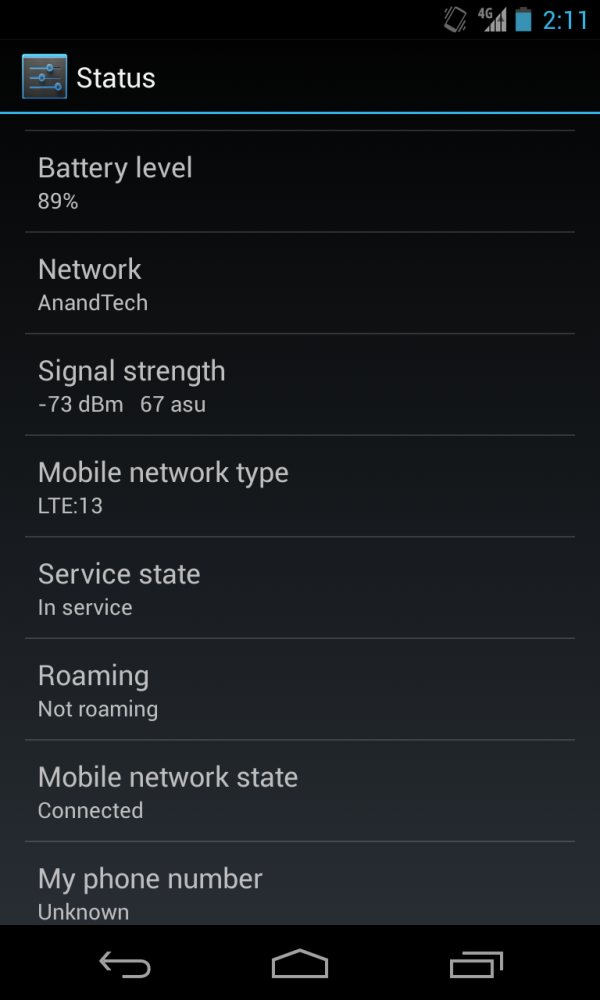
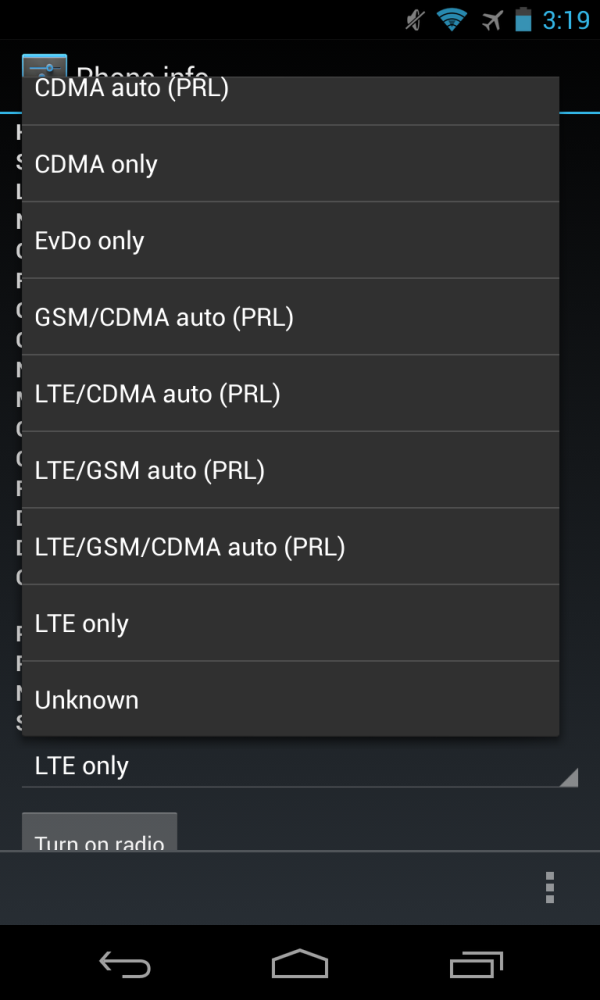
Nexus 4 on Band 4 LTE (Left), Band Preference Setting in *#*#4636#*#* (Right)
In the case of the Nexus 4, the hardware includes the latest and greatest cellular hardware from Qualcomm with MDM9215M, its third generation 28nm Category 3 LTE multimode baseband, and a WTR1605L transceiver. I tore down the Nexus 4 to ascertain whether PAs were present that could work with LTE, and saw indeed that at least bands 4, 2, and 1 did have Avago power amplifiers (A5704, A5702, and ACPM–7251) which noted support for LTE. The remaining piece of the puzzle was software stack, both in Android and inside the version of the AMSS (Advanced Mobile Subscriber Software) running onboard MDM9215M.
Recently some Nexus 4 owners in Canada posted on XDA that they had working LTE support on Band 4 if they enabled the appropriate "Preferred Network Type" in the dropdown menu there. This menu is inside "Phone Info" which has been part of Android forever and can be accessed on almost every Android phone either by dialing *#*#4636#*#* (INFO) or using an app called Phone Info which launches that activity directly.
Recently, Anritsu graciously loaned me an MD8475A signaling tester and LTE/WCDMA/CDMA2000 base station emulator for me to test and evaluate devices with. I tested the Nexus 4 on DC-HSPA+ for the review but didn't think to try testing LTE on the appropriate bands since Google and the FCC documents are both explicit about only WCDMA/GSM being present. I tested for LTE on all the bands that the Nexus 4 includes UMTS support for, starting with 5 MHz wide LTE channels. It appears that Nexus 4 only has support for LTE on Band 4 (AWS) with bandwidths up to 20 MHz in fact. I put together a table for easier parsing. If a band isn't listed, it isn't supported. Update: Lots of people have asked me to test some additional bands (3, 7, 20) because of their international relevance, these unsurprisingly are not supported given the fact that there are no PAs present for them. I've updated the table to be explicit however.
| Nexus 4 LTE Band Coverage | ||||
| E-UTRA (LTE) Band Number | Commonly Known Frequency (MHz) | Bandwidths Supported | ||
| 1 | 2100 | No Support | ||
| 2 | 1900 | No Support | ||
| 3 | 1800 | No Support | ||
| 4 | 1700/2100 | 5, 10, 20 MHz | ||
| 5 | 850 | No Support | ||
| 7 | 2600 | No Support | ||
| 8 | 900 | No Support | ||
| 20 | 800 | No Support | ||
Because testing the 2x2 MIMO configuration requires cabling up the Nexus 4 to the antenna leads directly, and my LG-appropriate antenna connectors haven't arrived yet, I only can test with a 1x1 configuration. The Nexus 4 does include Rx diversity for every band, and thus it's entirely possible on Band 4 that users will see the full 2x2 MIMO rates (37 Mbps on 5 MHz, 73 on 10 MHz, 100 Mbps on 20 MHz), but I can't confirm it directly. For the 1x1 configuration I could test, however, I saw the expected ~75 Mbps on 20 MHz FDD LTE which is very close to the maximum of 75.376 as shown.
The conclusion is that the Nexus 4 at present curiously includes the software profile on MDM9215M that enables support for LTE on Band 4 (AWS), and users only need to set the appropriate network type preference in Android to use it. None of the other bands that there are even power amplifiers for have LTE support, which is unfortunate for users in places where carriers aren't running LTE on AWS, such as the USA. For example, in the USA, AT&T previously discussed plans for LTE on Band 4 but has only rolled out LTE on Band 17 to date, and is rumored to be turning to refarming its PCS (1900 Band 2) and Cellular (850 Band 5) holdings for additional LTE capacity, perhaps in the stead of AWS. T-Mobile US however will use AWS for LTE. Nexus 4 LTE support is definitely unofficial (and somewhat surprising) at this point, but if you're lucky enough to be in a place where your carrier has rolled it out on Band 4, it's just a setting away.
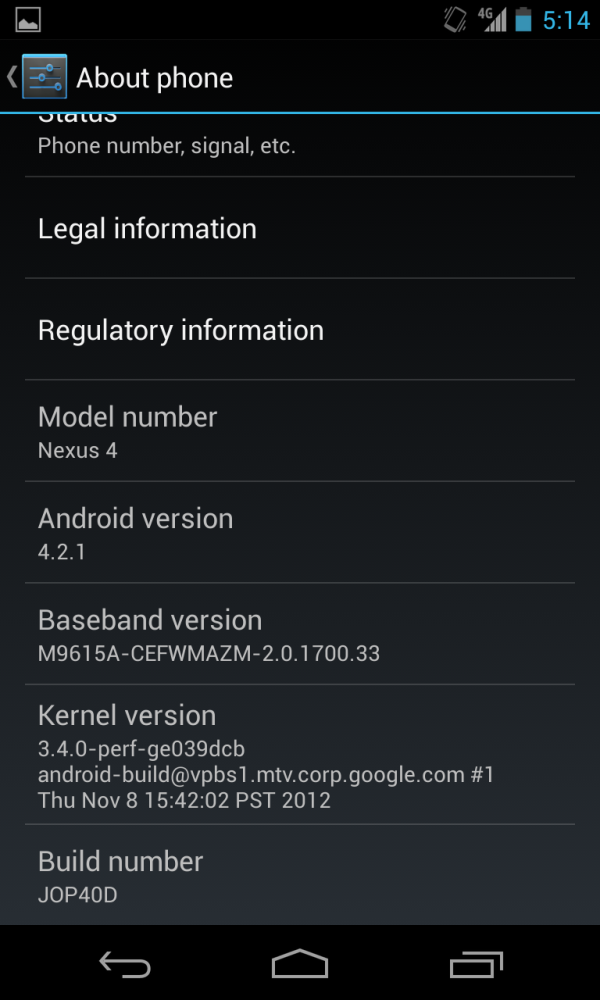
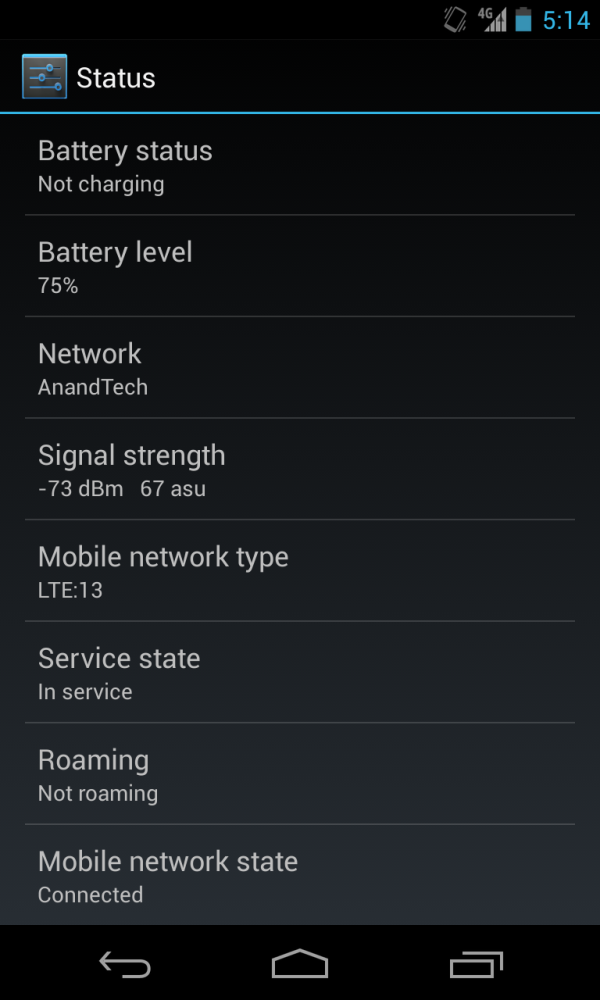
Still working on Android 4.2.1...
Update: This morning an update started rolling out to the Nexus 4, 7, and 10. I suspected initially that Google would quickly disable LTE on band 4 on the Nexus 4 for regulatory reasons (or file a Class II permissive change with the FCC). Interestingly enough the OTA going out to the Nexus 4 bringing it to build JOP40D doesn't disable LTE on band 4 or change the baseband software version at all. I was able to make the device attach the same was as I was previously. This update does fix the missing December option for birthdays in the People application, however.
Source: XDA Developers


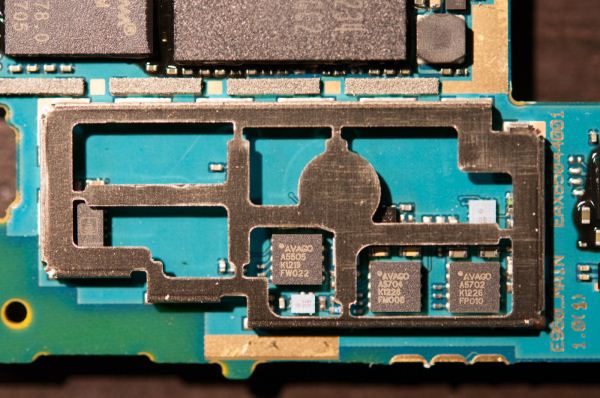














48 Comments
View All Comments
Paulman - Friday, November 23, 2012 - link
Now I'm excited to get a Nexus 4, possibly, instead of a Galaxy Note II. I'm a Canadian Rogers customer about 1 year into a 3 year contract with an LTE data plan. I'm currently stuck with a Galaxy S II (i9100) with no LTE support, but since the Galaxy Note II is about $700 outright, I think the much better deal would be to go with the Nexus 4, especially now that I know it has LTE capability (which some other Rogers customers have tried) :PI think the Galaxy Note II seems to have the leg up in terms of battery life, screen size (obviously), and nifty features like the pop-up view (Samsung only, I think?), but at effectively double the price, that's a pretty big difference.
Fiercé - Friday, November 23, 2012 - link
You're a Rogers Cellphone customer? You poor poor soul.How much would it cost you at this point to break your contract with them and take a Nexus 4 on a month-to-month plan? I'm honestly just curious as I try to stay away from them as much as possible, especially for Internet plans.
Or were you hoping to just use the Nexus 4 on your current plan?
LadyKate - Sunday, November 25, 2012 - link
Love my job, since I've been bringing in $5600… I sit at home, music playing while I work in front of my new iMac that I got now that I'm making it online(Click on menu Home)http://goo.gl/lb8tZ
Galcobar - Friday, November 23, 2012 - link
For clarity for those who are interested but unfamiliar (like I was about a month ago):The AWS frequency spectrum band refers to microwave data (including voice) transmissions, which run around 1700 MHz for uploads and around 2100 for downloads.
In Canada, the AWS band was the spectrum made available by the government in 2008 for auction.
Newcomers to the Canadian telecommunications industry such as Mobilicity, Wind and Videotron licensed the AWS band for UMTS communication (3G and HSPA's fake 4G). The big three firms of Rogers, Bell and Telus licensed the AWS spectrum they bought for use with the LTE protocol.
While they use the same frequencies, because the protocols are different a phone such as the Nexus 4 which is capable of LTE on AWS is not compatible with the networks which use UMTS on AWS.
plumcakk - Friday, November 23, 2012 - link
Except it is.Or else my N4 on Wind Mobile is running off thin air.
You can't just base a phone's ability to use UMTS on its LTE antennae. The N4 has 1700/2100 on its standard 3G receiver as well.
Galcobar - Saturday, November 24, 2012 - link
You're correct, and mea culpa -- I worded that last sentence quite incompetently.Note to self, try to avoid writing in the middle of the night.
I attempted, and clearly failed, to say that LTE isn't achievable on the Canadian networks using 1700/2100 for UMTS, even though the two protocols use the same frequenies in the Canadian market.
bill4 - Monday, November 26, 2012 - link
"fake hspa"Just like to point out HSPA isn't "fake": 4G by any definition.
Original 4G stipulated speeds 100X faster than 4G. Obviously, LTE doesn't qualify.
They then revised the spec to include both HSPA and LTE as 4G, even though NEITHER met the initial definition.
So if HSPA isn't 4G, neither is LTE. People who call LTE the "real" 4G are just arbitrarily making things up.
bill4 - Monday, November 26, 2012 - link
Sorry, obviously I meant original 4G spec called for 100X faster than 3G...typobill4 - Monday, November 26, 2012 - link
Oh and additionally, in many cases and markes, "fake 4g" HSPA+ is faster than "real 4g" LTE. Further pointing out the absurdity.DAN13L - Monday, November 26, 2012 - link
That is True, I have AT&T in the US and in some areas, my HSPA+ is faster than LTE but with a slower ping.